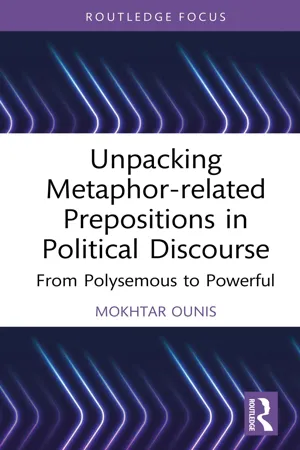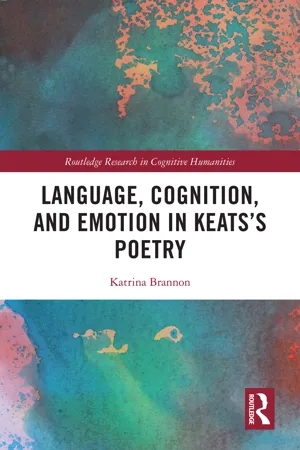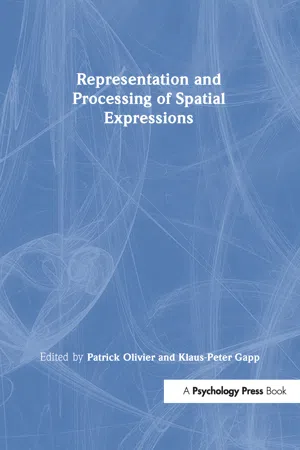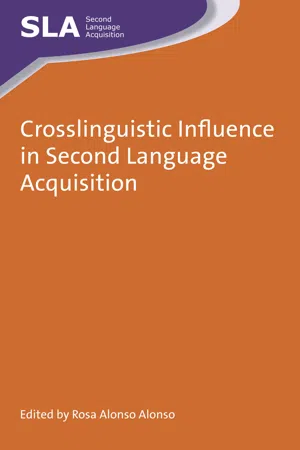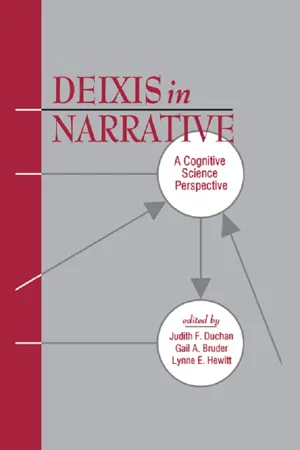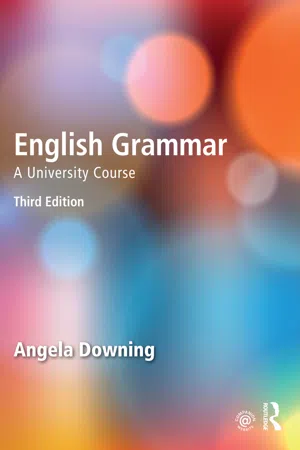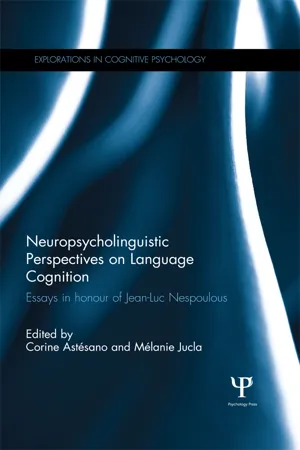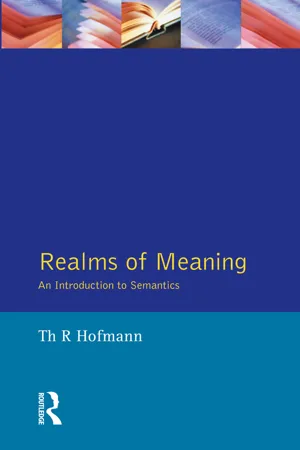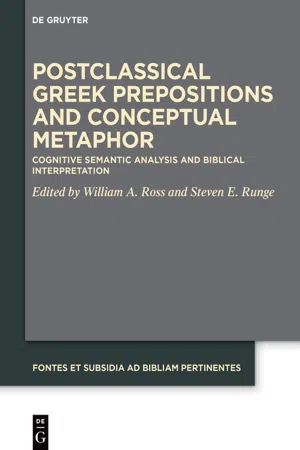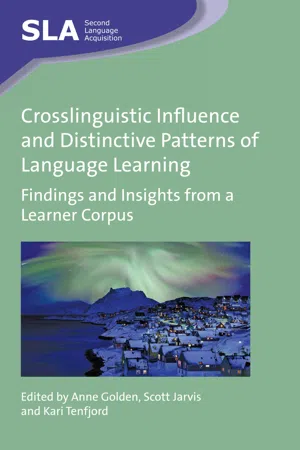Languages & Linguistics
Prepositions of Place
Prepositions of place are words that indicate the location of an object or person in relation to another object or place. Common prepositions of place include "in," "on," "at," "under," "behind," and "beside." These prepositions help to describe the position of things in a sentence and are essential for understanding spatial relationships in language.
Written by Perlego with AI-assistance
Related key terms
Related key terms
1 of 4
Related key terms
1 of 3
12 Key excerpts on "Prepositions of Place"
- eBook - ePub
Unpacking Metaphor-related Prepositions in Political Discourse
From Polysemous to Powerful
- Mokhtar Ounis(Author)
- 2023(Publication Date)
- Routledge(Publisher)
These dictionary entries consistently highlight two main characteristics of prepositions: first, their position within a sentence, and second, their function. Prepositions are defined based on their location in relation to other entities within the sentence. Three out of the five definitions incorporate the term “before”, while the fourth definition employs the term “preceding” to emphasize that this positional aspect is intrinsic to the meaning of the preposition.The etymology of the word “preposition” underscores its inherent emphasis on position. Its origins trace back to the Latin term praeponere, which combines the prefix prae, denoting “before” or “in front of”, with the verb ponere, meaning “to place” or “to put”. As such, a preposition signifies an element intended to be positioned before or placed in front of another entity within a sentence.In addition to their positional aspect, prepositions have another distinct feature: their function. Both dictionaries and grammar textbooks define prepositions by the function of creating a relation between two entities within a sentence. For example, Quirk et al. (1985 : 657) assert that “a preposition expresses a relation between two entities, one being that represented by the prepositional complement, the other by another part of the sentence”. Additionally, the Longman Grammar of Spoken and Written English, a classical grammar reference, defines a preposition as “mortar which binds [the main building blocks of] texts together” (Biber et al. 1999 : 55).When these two aspects are combined, a preposition signifies an entity intended to be positioned before another entity while simultaneously establishing a relationship between the preceding entity and the succeeding entity.While these two dimensions distinguish a preposition from other parts of speech, they alone are insufficient to fully define its precise meaning. The question arises: is the meaning of a preposition independent or contingent on the relations it establishes, or is it a combination of both? Regarding the first view, it posits that a preposition possesses a fundamental semantic value that is accompanied by a constellation of interconnected meanings. Alternatively, the second view posits that prepositions derive their meanings through their semantically related associations and that these meanings can be accurately determined and anticipated via computational means, as explained by Srikumar and Roth (2013 - eBook - ePub
Saying, Seeing and Acting
The Psychological Semantics of Spatial Prepositions
- Kenny R. Coventry, Simon C. Garrod(Authors)
- 2004(Publication Date)
- Psychology Press(Publisher)
Spatial prepositions are commonly divided further into locative or relational prepositions (H. Clark, 1973) and directional prepositions (Bennett, 1975). Locative or relational prepositions describe the location of one object in relation to another (e.g., Keith is in his office), whereas directional prepositions describe a change of position (e.g., Simon went to the eye-tracker room — a few minutes ago) or direction in which an object is located (e.g., The wind vane pointed to the north). To give a more complex example (from Bennett, 1975, p. 18), We went from Waterloo Bridge along the Embankment to Westminster describes a starting point, a change of location, and the path taken during the change of location. Locative/relational terms are often further broken down into topological terms on the one hand and projective terms on the other (sometimes also called dimensional terms; see Retz-Schmidt, 1988). Topological terms include prepositions such as in, on, and near, which usually refer to (static) topological relations between objects. For our purposes, we can further distinguish between the simple topological terms in and on and proximity terms such as near and far, which give information about the distance between objects. Projective terms, such as in front of, to the left of, and above convey information about the direction in which one object is located with reference to another object. However, they are special in that they depend for their interpretation upon a particular spatial frame of reference. In turn, this means that each term can be used in several different ways. As Levinson (1996a) has noted, the classification of frames of reference in familiar European languages remains confused, and we therefore follow Levinson's (“suitably catholic”) distinction between three basic reference frames (which can be further subdivided; see, for example, Jackendoff, 1996) - eBook - ePub
- (Author)
- 2013(Publication Date)
- Collins Cobuild(Publisher)
6.72 Like prepositional phrases, adverbs can also be placed after nouns.They watched him from the terrace above .The man opposite got up.People everywhere are becoming aware of the problem.We took the road south .Prepositions
6.73 This section explains how prepositional phrases are used to show the place where an action occurs, the place where someone or something is, the place they are going to or coming from, or the direction they are moving in.A prepositional phrase consists of a preposition and its object , which is nearly always a noun.The most basic use of most prepositions is to indicate position and direction.He fumbled in his pocket . On your left is the river.Why did he not drive to Valence ?The voice was coming from my apartment .I ran inside and bounded up the stairs .Here is a list of common one-word prepositions that are used to talk about place or destination:6.74 A preposition is a word that allows you to say more about a thing or an action, because you can choose any appropriate noun after it as its object. Most prepositions are single words, although there are some that consist of more than one word, such as out of and in between .about above across along alongside among around at before behind below beneath beside between beyond by down from in inside into near off on opposite outside over past round through throughout totoward (Am)towards under underneath up withinNote that toward and towards are both used in American English, with no difference in meaning.Here is a list of prepositions that consist of more than one word and that are used to talk about place or destination:across from ahead of all over away from close by close to in between in front of near to next to on top of out of6.75 Many prepositions can also be adverbs; that is, they can be used without an object. See paragraph 6.54 for a list of these.BE CAREFUL
- Katrina Brannon(Author)
- 2022(Publication Date)
- Routledge(Publisher)
Prepositions play an essential, constructive, and linking role in grammar and semantics. In regard to this, Gibbs remarks that “prepositions seem to be particularly good at pushing their objects around” (1994 : 48). Furthermore, one intrinsic quality of prepositions in language is their ability to express the notions of space and time, which are very often conceptualized and verbalized metaphorically, as there is an inherent “thematic parallelism between space and time that results in a single set of abstract relations between the two domains [of space and time]” (Gibbs 1994 : 168). Thus, it is logical to see prepositions as grammatical elements which are fundamentally metaphorical, given the fact that their primary vocation within language is to allow for the expression of processual relationships. This unique quality of prepositions thus renders them particularly salient in the analysis of conceptual metaphor, particularly within poetic language, as the combination and multiplication of metaphorical expression is central. As R. Gibbs observes, “metaphorical mappings do not occur in isolation from one another” (Gibbs 1994 : 152). This leads to reflection upon the intrinsic metaphoricity of grammatical classes and the ways in which they are capable of rendering conceptually metaphorical concepts more salient metaphorically, by way of the superposing of “higher and lower metaphorical mappings” (Gibbs 1994 : 152). Therefore, prepositions are key to the full expression of conceptual metaphor: particularly in poetic metaphor, within which the combination of metaphorical mappings is most welcome. Spatial prepositions, moreover, play a special role in metaphoric expression. 1 In Chapter 4, I delved into the inherent link between conceptual metaphor and force-dynamic expressions. This exploration will continue in the present chapter, as prepositions hold an important role in causality- Patrick Olivier, Klaus-Peter Gapp(Authors)
- 1998(Publication Date)
- Psychology Press(Publisher)
Also in the case of prepositions, in fact, the knowledge about the arguments has a fundamental impact on the interpretation of a relation (expressed via a preposition and not via a verb). The main difference is that we do not assume any fixed structure in the representation of objects (such as Qualia Structure proposed by Pustejovsky): Spatial properties are represented together with all other properties of a given object. In this chapter we deal exclusively with static spatial locative expressions, that is, expressions such as the ones appearing in (1), where the location of an object is described via a reference to the known location of another object. In the literature, the first object is called the relatum (Miller & Johnson-Laird, 1976), the figure (Talmy, 1985), or the trajector (Lakoff, 1987; Langacker, 1991) and the second object is respectively called the referent, the ground, or the landmark. We follow Herskovits (1986) and use the terms located object and reference object. The following section includes a short review of the current theories on the meaning of prepositions. The next three sections describe our approach: lexical and terminological knowledge, semantic representation, and interpretation. An example and some conclusions close the chapter. 2. THEORIES OF THE MEANING OF PREPOSITIONS AND ON SPATIAL RELATIONS Theories of the meaning of locative prepositions can be classified as simple relations models versus multiple relations models (cf. Herskovits, 1986). The first class includes theories coming both from linguistics (Bennett, 1975) and from the computational paradigm (Boggess, 1979; Cooper, 1968; Miller & Johnson-Laird, 1976; Waltz, 1980). Presumably, the position of Jackendoff (1983, 1990) also falls in this class. The basic idea of these approaches is that all spatial uses of a given preposition can be derived from a single geometric relation, whose arguments are the reference (background) object and the located object- Rosa Alonso Alonso(Author)
- 2016(Publication Date)
- Multilingual Matters(Publisher)
The fact that languages divide up and lexicalise spatial configurations and functions in different ways has also been addressed by Tyler and Evans (2003) in their Principled Polysemy Model, which provides a cognitive linguistics account of the various meanings associated with English prepositions in terms of systematically related polysemy networks. We recognise the value of this powerful model but do not rely on it in the present study because of the nature of our analysis, which focuses on learners’ choice of spatial prepositions in contexts that reflect fairly prototypical meanings of IN, ON and AT. Our study is nevertheless motivated by a cognitive linguistics perspective that assumes crosslinguistic differences in the ways that speakers of different languages construe spatial configurations. We now turn to the findings of previous research regarding crosslinguistic differences and crosslinguistic influence in the expression of spatial relationships.Crosslinguistic Differences and Crosslinguistic Influence in the Expression of Spatial RelationshipsOne of the misconceptions about spatial prepositions is that their use is determined solely by the spatial and geometrical configurations of the objects whose relationships they refer to (e.g. apple in a bowl , pen on a table ). Although some prepositions in some languages (e.g. above in English) might refer relatively straightforwardly to geometrical configurations (but see Tyler & Evans, 2003), others are chosen more on the basis of extra-geometric information, such as location control. Location control refers to the likelihood that if the reference object moves, the located object will move with it (Coventry & Guijarro-Fuentes, 2008). The English preposition IN is chosen on the basis of both geometric (containment) and extra-geometric (location control) criteria. For example, an apple that is sitting inside a bowl is deemed by English speakers to be in the bowl because the apple is at least partially contained by the bowl and because the apple will move with the bowl if the bowl moves. An apple that is on a table underneath an upside-down bowl, on the other hand, is not in the bowl because, even though the apple is contained by the bowl, the apple will not move when the bowl moves. Studies reviewed by Coventry and Guijarro-Fuentes (2008) show that pre-linguistic infants are sensitive to both geometric and extra-geometric information in preferential looking tasks, and that it is not until infants begin acquiring their native language that their preferences become more language-specific (see also Bowerman & Choi, 2001; McDonough et al- eBook - ePub
Deixis in Narrative
A Cognitive Science Perspective
- Judith F. Duchan, Gail A. Bruder, Lynne E. Hewitt, Judith F. Duchan, Gail A. Bruder, Lynne E. Hewitt(Authors)
- 2012(Publication Date)
- Psychology Press(Publisher)
Because these spatial relations constitute propositions that assert an abstract place as a satellite place within the semantic vicinity of the ground object, we call them spatial proximity functions. These are typically expressed by directional relations (such as in front of behind, to the left of), inclusion relations (such as in, out of, on, between, beside), or distance relations (such as near to, away from). Spatial case relations and various spatial proximity functions are both coded in English by spatial prepositions (as well as by some preposition clusters). Clark (1973) analyzed the propositions into and onto as compositions of in with to and on with to, respectively. Our analysis is an extension of Clark’s analysis. English spatial prepositions (and preposition clusters) are a surface amalgamation of a spatial deep case marker with a spatial proximity function. For example, the prepositional phrase, “in the room,” in the sentence, John stayed in the room, is analyzed as a surface realization of something equivalent to “AT some place P where P is-IN the room.” In other words, this analysis decomposes the surface prepositional phrase in the room into a case component containing a deep spatial case marker AT and an abstract place argument, and a spatial proximity function component that asserts the spatial proximity relation is-IN held by the abstract place to the ground object, the room. In Sentences 4a and 4b, 4 The mouse lives under the tree where Tom found the eagle’s nest. The mouse lives under the tree where Tom found many strange rocks. the places qualified by the two where-clauses are two different places despite their analogous surface syntactic configuration. The analysis that we argue for accounts for this structural ambiguity - eBook - ePub
English Grammar
A University Course
- Angela Downing(Author)
- 2014(Publication Date)
- Routledge(Publisher)
on ) – in the most basic use. Further uses can then be explained as modifications of the basic image schema, as these mental pictures are perceived and derived from our experience of the world.- Many basic patterns of spatial location are carried over to time relations, such as in the house, in November, in 1492 , and to ordinary metaphorical uses which form part of our daily interaction (in love, in time, in pain ).
59.1 Two Types of Prepositional Meanings
Prepositional meanings can be divided into two broad types:- those in which the choice of preposition is determined by the verb, noun or adjective preceding it; and
- those in which a preposition is chosen freely in accordance with the speaker’s intentions.
grammaticised I agree with you; we rely on you; fruit is good for you.lexical We flew/in /into /out of /through /above /below /close to / near/a long way from the clouds .In previous sections we have discussed those prepositions which are determined by nouns (→ 50.5), adjectives (→ 53.1.3) and verbs (→ 6.3.1; 10.5) (e.g. look after, rely on, put up with). These are all grammaticised; that is to say, in such cases the preposition does not have its full lexical meaning and is not in open choice with other prepositions. We noticed that nouns which take prepositional complements are related to cognate verbs or adjectives that often take the same prepositional complement, as in the following examples: - eBook - ePub
Neuropsycholinguistic Perspectives on Language Cognition
Essays in honour of Jean-Luc Nespoulous
- Corine Astesano, Mélanie Jucla(Authors)
- 2015(Publication Date)
- Psychology Press(Publisher)
Space in languages: Linguistic systems and cognitive categories (pp. 29–58). Amsterdam/Philadelphia: John Benjamins.Herskovits, A, 1982. Space and the prepositions in English: Regularities and irregularities in a complex domain . (Doctoral dissertation). Stanford University.Herskovits, A., 1986. Language and spatial cognition: An interdisciplinary study of the prepositions in English . Cambridge: Cambridge University Press.Jackendoff, R., 1983. Semantics and cognition . Cambridge, MA: MIT Press.Jackendoff, R., 1990. Semantic structures . Cambridge, MA: MIT Press.Kay, P. & McDaniel, C. K., 1978. The linguistic significance of the meanings of basic color terms. Language , 54, 610–646.Kay, P. & Maffi, L., 1999. Color appearance and the emergence and evolution of basic color lexicons. American Anthropologist , 101 (4), 743–760.Koopman, H., 2000. Prepositions, postpositions, circumpositions, and particles. In H. Koopman (Ed.), The syntax of specifiers and heads (pp. 204–260). London: Routledge.Kracht, M., 2002. On the semantics of locatives. Linguistics and Philosophy , 25(2), 157–232.Landau, B. & Jackendoff, R., 1993. “What” and “where” in spatial language and spatial cognition. Behavioral and Brain Sciences , 16, 217–238.Leech, G. N., 1969. Towards a semantic description of English . London: Longman.Levinson, S. C., 1994. Vision, shape, and linguistic description: Tzeltal body-part terminology and object description. Linguistic , 32, 791–855.Levinson, S. C. & Meira, S., 2003. ‘Natural concepts’ in the spatial topological domain – adpositional meanings in crosslinguistic perspective: An exercise in semantic typology. Language , 79(3), 485–516.Noonan, M., 2010. À to Zu. In G. Cinque & L. Rizzi (Eds.), Mapping spatial PP, Vol. 6: The cartography of syntactic structures (pp. 161–195). Oxford: Oxford University Press.Ospina Bozzi, A. M., 2010. Localización estática en yuhup. In G. Cabrera Becerra (Ed.), Viviendo en el bosque: Un siglo de investigaciones sobre los makú del Noroeste amazónico - eBook - ePub
Realms of Meaning
An Introduction to Semantics
- Thomas R. Hofmann(Author)
- 2015(Publication Date)
- Routledge(Publisher)
Chapter 9 PrepositionsWhat can you answer if someone asks you which is correct?on his way to New York (a) he stopped at Chicago. (b) he stopped in Chicago.Of course, they are both correct but differ a little in meaning. The first suggests that he didn’t spend more than a few hours in Chicago, while the other implies at least a day’s stay. How can this be?In many languages prepositions are used to show aspects of location of an event — whether something happened, for example, in, on, at or near my house. English has a rather extensive set of such prepositions and uses them to carry meaning for which other languages commonly use nouns or verbs. In Chinese, for example, we would not watch television in the kitchen but ‘at the kitchen’s inside’. English uses prepositions so much that we might even call it a ‘prepositional language’. Here we will break down some of this complexity, and in the process find semantic elements that play important roles in most if not all languages.As with the arrays of deictic markers in Chapter 4 , the way the meanings of English prepositions break down into elementary meanings shows again that many words can be decomposed into semantic elements. In fact, English prepositions are so extensive that there is probably no other way to learn them — to list all the possible uses of each one in a dictionary would be nearly endless, and almost useless for most language learners.Although we shall be concerned primarily with prepositions in English, a great many languages are like Japanese and use postpositions instead. These are nearly the same as prepositions except that they are after (post-) the nominal instead of before it as prepositions are. The only other difference is that there is no stopping between a noun and a postposition.1 - eBook - ePub
Postclassical Greek Prepositions and Conceptual Metaphor
Cognitive Semantic Analysis and Biblical Interpretation
- William A. Ross, Steven Edward Runge, William A. Ross, Steven E. Runge(Authors)
- 2022(Publication Date)
- De Gruyter(Publisher)
2 Greek Prepositions: A Cognitive Linguistic ViewRichard A. RhodesThe purpose of this essay is to bring insights that Cognitive Linguistics offers to bear on some select postclassical Greek prepositions.1 The general topic of prepositional meaning has a very extensive literature in Cognitive Linguistics. The fundamental insights on how prepositions profile spatial scenes are most fully articulated in Ronald Langacker.2 Some important earlier works developed then nascent insights into prepositional and particle meanings extensively, in particular Claudia Brugman and Susan Lindner, laying the foundation for how Cognitive Linguists now think about prepositional meaning.3 The best summary of cognitive thought on prepositional meaning can be found in Andrea Tyler and Vyvyan Evans’s book on the semantics of English prepositions.4As for new work on postclassical Greek prepositional meaning, the approaches have been either lexicographic or didactic. The lexicographers catalogue the various usages of Greek prepositions encountered in the texts, and organize them into senses based on the judgment of the lexicographer. For example, LSJ lists a grouped set of meanings for ἐν, including in; within, surrounded by; on, at, or by; in the number of, amongst; in one’s hands, within one’s reach or power; in respect of. On the other hand, many language teaching materials give as a learning tool a figure such as that in Figure 2.1. 5 In neither the lexicographic nor the didactic presentation of the data is any overarching analysis offered.Figure 2.1: A traditional visual representation of Greek preposition meanings.Cognitive Linguistics, on the other hand, offers a principled way to understand the kinds of meanings prepositions express. The cognitive view of language is that meaning arises out of perceptual experience. “Meaning is not objectively given, but constructed, even for expressions pertaining to objective reality. We therefore cannot account for meaning by describing objective reality but only by describing the cognitive routines that constitute a person’s understanding of it.”6 - eBook - ePub
Crosslinguistic Influence and Distinctive Patterns of Language Learning
Findings and Insights from a Learner Corpus
- Anne Golden, Scott Jarvis, Kari Tenfjord, Anne Golden, Scott Jarvis, Kari Tenfjord(Authors)
- 2017(Publication Date)
- Multilingual Matters(Publisher)
på . Thirty native speakers of Norwegian from various backgrounds were presented with a fill-in-the-blank-test containing 127 phrases with the prepositions removed. Thirty Polish learners whose proficiency in Norwegian was assessed at the B1 level (intermediate) on the Common European Framework of Reference for Languages (CEFR) scale were then presented with the same test. The study showed that although the overall error rate was not that high, there were some phrases that were transferred directly from Polish, resulting in errors in the L2. Some of the errors appeared to be motivated by different categorizations of place, for example involving locations that tend to be construed by Norwegian speakers as containers but by Polish speakers as surfaces, or the other way around. Interestingly, the study also showed that although some prepositional phrases could be transferred directly into Norwegian and remain correct, the learners often chose other Norwegian prepositions that were not grammatical in the given context.Prepositions in Polish and NorwegianIn both languages, all three frames of reference (absolute, relative and intrinsic) are applicable and used with more or less the same frequency, which makes the perception of space rather similar. An absolute frame of reference is the most original and probably applicable frame as an object is defined in relation to cardinal directions, i.e. North, South, East and West, or fixed bearings such as seacoast, upriver/downriver, uphill/downhill (e.g. the lake is to the south of the house). When it comes to a relative frame of reference, the location of an object is expressed in relation to the viewpoint of the perceiver and position of another object, e.g. he girl sits next to the bus stop. An intrinsic frame, on the other hand, is a binary spatial relation in which the location of an object is defined in relation to a part of another object (its side, back, front, etc.), e.g. the car is in front of the house.In general, native speakers of Polish and Norwegian understand and express spatial relations in a very homogenous way, i.e. using prepositions. As mentioned before, one can even talk about rough translation equivalents of Polish prepositions in Norwegian, w being i and na being rendered by på.A Polish prepositional phrase consists of a preposition and a noun with a suffix representing an appropriate case. With spatial prepositions in Polish, the noun is predominantly inflected into locative case, but genitive and accusative are also sometimes possible. In Norwegian, on the other hand, which lacks nominal case and case suffixes, a prepositional phrase is formed by a preposition and a bare noun (along with possible determiners, modifiers and suffixes representing number and definiteness). The fact that Polish is a case language and Norwegian is not might seem like a trivial difference when it comes to the choice of appropriate spatial prepositions. The present study nevertheless explores the possibility that this difference might have profound consequences for how Polish-speaking learners use Norwegian prepositions.
Index pages curate the most relevant extracts from our library of academic textbooks. They’ve been created using an in-house natural language model (NLM), each adding context and meaning to key research topics.
Explore more topic indexes
Explore more topic indexes
1 of 6
Explore more topic indexes
1 of 4
